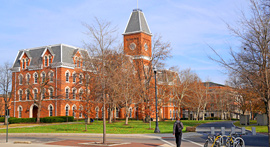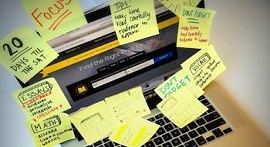UMBC, a selective public research university, combines the traditions of the liberal arts academy, the creative intensity of the research university, and the social responsibility of a public institution. We are known for integrating research, innovative teaching and learning, and civic engagement so that each advances the others for the benefit of society.
About
From the School
Contact & Visit
Campus Visits Contact
Senior Assistant Director of Campus Visits and Events
1000 Hilltop Cir
Baltimore, MD 21250
Experience College Life
The Commons
Performing Arts and Humanities Building
Chesapeake Employers Insurance Arena
Starbucks/Chick-Fil-A
Students attend, and take part in, a world of excellent theatre, music and dance performances on campus. They go to art openings and lectures, start clubs and exchange ideas through the campus paper and literary magazines.
Washington D.C.
Patapsco State Park
Historic Ellicott City
Annapolis
UMBC is located 10 miles southwest of downtown Baltimore which provides easy access to entertainment, cultural activities and a wealth of opportunities for research, cooperative education and internship in a diversity of public and private organizations in the Baltimore-Washington area.
Campus Tours
Dates: Year-round
Times: Varies
Average Length: 2 hours
On Campus Interview
Faculty and Coach Visits
Class Visits
Overnight Dorm Stays
Transportation
Admissions
Admissions
Overall
From The School
UMBC is adopting a test-optional admissions program for Fall 2021 applicants in light of the COVID-19 pandemic and its impact nationally on high school students' ability to access standardized admissions tests (SAT/ACT). The test-optional program provides students the opportunity to apply for undergraduate admission with or without standardized test scores. Students applying without standardized test scores will receive full consideration for admission, merit scholarships and other opportunities.
UMBC's holistic review of applicants for undergraduate admission considers a number of factors. These include grade point average, academic trend, strength of curriculum, standardized test scores (if provided), personal statement, letters of recommendation, and other achievements. Students wishing to be considered for undergraduate admission should submit an application and all required documents by November 1 for Early Action and February 1 for Regular Decision.
Transfer applicants are considered to be students who have completed a minimum of 24 college-level credits at an institution of higher education after receiving a high school diploma or a GED. The Admissions Committee evaluates transfer applicants on the basis of their academic record at previous institutions. Cumulative grade point average as calculated by UMBC, academic trends, strength of curriculum, and performance in courses related to the intended area of study are considered. Special consideration will be given to students who complete an associate degree at a Maryland two year institution.
Overview
GPA Breakdown
Need to boost your grades? We can help.
Learn MoreSAT & ACT Test Scores
Testing Policies
Deadlines
Early Action — November 1
Regular — February 1
Other Admission Factors
Rigor of Secondary School Record
Academic GPA
Application Essay
Recommendation(s)
Selectivity Rating
Get a personalized plan for a competitive application from an admissions expert.
Learn MoreAcademics
Academics
Overall
From The School
Academic Programs
UMBC's academic calendar consists of fall and spring semesters, a four-week session in January, and two summer sessions from six to eight weeks. To receive a UMBC degree, students complete at least 120 credits. In addition to the requirements for the chosen major, the general education program (GEP), provides a solid basis for a lifetime of learning. GEP courses encompass humanities and fine arts, mathematics and natural sciences, social sciences, and languages and culture.
The Honors College at UMBC is a special option for students who want to be surrounded by others committed to intellectual inquiry, hard work, and interdisciplinary learning. Honors College students dive deep into their studies and interests both in and out of the classroom through events and opportunities for research, study abroad, and more. Students also choose from seminars with some of the University's top professors. Examples include: Physiology of Dinosaurs, Race, Poverty, and Gender in Baltimore, and Feast and Fast in Medieval Literature.
At UMBC, we've also built a unique set of programs dedicated to helping you make a big change in the world. In these programs, you'll earn scholarships to help finance your education, but you'll also find a supportive community that is focused on giving you a launchpad for your academic, career, and life goals. Some of UMBC's scholars programs include: The Center for Women in Technology (CWIT), The Cyber Scholars program, The Humanities Scholars program, The Linehan Artist Scholars program, The Meyerhoff Scholars program, The Sherman Scholars Program, and The Sondheim Scholars program.
Majors and Degrees Offered
UMBC offers a wide variety of programs including some that cross disciplines to create exciting new opportunities for research and learning, such as Entrepreneurship and Innovation, Game Development, and Cybersecurity.
Faculty and Class Information
Graduation Rates
Majors
-
AREA, ETHNIC, CULTURAL, GENDER, AND GROUP STUDIES.
African-American/Black Studies.
American/United States Studies/Civilization.
Asian Studies/Civilization.
Ethnic, Cultural Minority, Gender, and Group Studies.
Women's Studies.
-
BIOLOGICAL AND BIOMEDICAL SCIENCES.
Biochemistry and Molecular Biology.
Bioinformatics.
Biology/Biological Sciences, General.
Biotechnology.
-
BUSINESS, MANAGEMENT, MARKETING, AND RELATED SUPPORT SERVICES.
Business Administration, Management and Operations, Other.
Management Information Systems and Services.
-
COMMUNICATION, JOURNALISM, AND RELATED PROGRAMS.
Mass Communication/Media Studies.
-
COMPUTER AND INFORMATION SCIENCES AND SUPPORT SERVICES.
Computer and Information Sciences, General.
Computer Science.
Information Science/Studies.
-
EDUCATION.
Biology Teacher Education.
Chemistry Teacher Education.
Junior High/Intermediate/Middle School Education and Teaching.
Mathematics Teacher Education.
Physics Teacher Education.
Science Teacher Education/General Science Teacher Education.
Technology Teacher Education/Industrial Arts Teacher Education.
-
ENGINEERING.
Chemical Engineering.
Computer Engineering, General.
Mechanical Engineering.
-
ENGLISH LANGUAGE AND LITERATURE/LETTERS.
-
FAMILY AND CONSUMER SCIENCES/HUMAN SCIENCES.
Adult Development and Aging.
-
FOREIGN LANGUAGES, LITERATURES, AND LINGUISTICS.
Foreign Languages and Literatures, General.
-
HEALTH PROFESSIONS AND RELATED PROGRAMS.
Emergency Medical Technology/Technician (EMT Paramedic).
Health Information/Medical Records Technology/Technician.
-
HISTORY.
History, General.
-
MATHEMATICS AND STATISTICS.
Mathematics, General.
Statistics, General.
-
MULTI/INTERDISCIPLINARY STUDIES.
Classical and Ancient Studies.
International/Global Studies.
Multi-/Interdisciplinary Studies, Other.
-
NATURAL RESOURCES AND CONSERVATION.
Environmental Studies.
-
PHILOSOPHY AND RELIGIOUS STUDIES.
Philosophy.
-
PHYSICAL SCIENCES.
Chemistry, General.
Physics, General.
-
PSYCHOLOGY.
Psychology, General.
-
PUBLIC ADMINISTRATION AND SOCIAL SERVICE PROFESSIONS.
Health Policy Analysis.
Public Policy Analysis, General.
Public Policy Analysis, Other.
Social Work.
-
SCIENCE TECHNOLOGIES/TECHNICIANS.
Science Technologies/Technicians, General.
-
SOCIAL SCIENCES.
Anthropology.
Economics, General.
Geography.
Political Science and Government, General.
Sociology.
-
VISUAL AND PERFORMING ARTS.
Acting.
Dance, General.
Design and Visual Communications, General.
Drama and Dramatics/Theatre Arts, General.
Fine and Studio Arts.
Jazz/Jazz Studies.
Music Pedagogy.
Music Performance, General.
Music Technology.
Music Theory and Composition.
Students Say
Degrees
Certificate
Doctoral
Doctoral/Research
Master's
Post-Bachelor's certificate
Post-Master's certificate
Career Services
Alumni Network
Alumni Services
Classes
Interest Inventory
Internships
Regional Alumni
Coop
Experiential
Internship
Prominent Alumni
Academic Rating
Careers
Graduation Rates
Career Services
Alumni Network
Alumni Services
Classes
Interest Inventory
Internships
Regional Alumni
Coop
Experiential
Internship
ROI & Outcomes
Students Say
Tuition & Aid
Tuition & Aid
Overview
From The School
Tuition, Room, Board and Fees
Tuition and fees for 2019 2020 are $12,028 for Maryland residents and $27,662 for out-of-state students. Room and board averages $12,350.
Financial Aid
Forbes, Kiplinger, and Business First all agree that UMBC is a great value, thanks to its unique offerings, vibrant student-life, and athletics as compared to cost.
A variety of need-based financial aid programs are available, awarded in three categories: grants, loans, and employment. The Office of Financial Aid will prepare a financial aid package for eligible students which may consist of one or more of these types of aid to assist in meeting a student's financial needs. Eligibility is calculated based on FAFSA results, so make sure to apply online between October 1 and February 14.
UMBC offers a range of Merit Awards to both in-state and out-of-state students. Prospective incoming freshmen who submit timely applications will be reviewed for awards based on high school program, individual grades, cumulative averages, and SAT or ACT scores (if submitted). UMBC awards merit scholarships automatically to eligible incoming freshmen: no separate application needed. Awards range from $1,000 to $12,000 per year.
Dates
Required Forms
Financial Aid Statistics
Expenses per Academic Year
Available Aid
Need-Based College/University Scholarship or Grant Aid from Institutional Funds
Need-Based Federal Pell
Need-Based Private Scholarships
Need-Based SEOG
Need-Based State Scholarships
Need-Based United Negro College Fund
Direct Subsidized Stafford Loans
Direct Unsubsidized Stafford Loans
Financial Aid Rating
Student Body
Student Body
Overall
From The School
A big part of what makes UMBC different is that we're truly a community of learners. Whoever you are, whatever your interests, you'll find friends and professors here who will share your passions – and broaden your perspective. At UMBC, students from across the country and around the world (more than 80 different countries are represented here), come together in a collaborative culture that both challenges and supports everyone to push boundaries and make big breakthroughs. You can be yourself – and become your best self – at UMBC.
With more than 250 clubs and organizations, you'll find students interested in everything from food, culture, and the arts to athletics, anime, engineering, world politics, faith and more. And, at a host of campus-wide events each year like Homecoming and Quadmania, you'll enjoy festivals, parties, concerts and comedy shows.
Student Body Profile
Demographics
Students Say
Campus Life
Campus Life
Overview
From The School
Location
UMBC is just 15 minutes from Baltimore's Inner Harbor and 30 minutes from Washington, D.C., in suburban Catonsville, Maryland. BWI Airport is five minutes away, as are AMTRAK and light rail stations. University-run Shuttle buses provide regular transportation to points in the surrounding area and Baltimore City. The Baltimore-Washington area is known for its music, sports, museums, restaurants, and historical traditions.
UMBC's main campus is located on 530 wooded acres, featuring housing and dining facilities on one side and core facilities on the other. Facilities include classroom and lab buildings, a performing arts center, a library, galleries, a student union, a bookstore, an Olympic-size pool, tennis courts. A newly renovated rec center includes an indoor track, basketball courts, a weight room, a spin room, and cardio and group fitness spaces. The campus also features an environmental conservation area with a hiking trail and bwtech@UMBC, an adjacent research and technology park that attracts firms in fields including engineering, information technology, and the life sciences.
Campus Facilities & Equipment
The Interdisciplinary Life Sciences Building includes facilities such as 12 research labs, an environmental systems lab, and a BioProcess and Cell Science Facility, as well as lecture and seminar classrooms. Other scientific research equipment includes the world's largest nuclear magnetic resonance spectrometers, housed in the only Howard Hughes Medical Institute lab at a public University in Maryland, where students have the opportunity to conduct AIDS research alongside top faculty in the field.
The Performing Arts and Humanities Building at UMBC houses performance spaces that showcase the University's strong arts and humanities programs and creates a regional and national appreciation of the Baltimore area's strong arts community.
The UMBC Event Center seats 6,000 and hosts a variety of sports and entertainment events. The Commons, UMBC's student center, includes a food court, the University bookstore, a full-service bank, and student organization spaces.
UMBC's landmark building, the Albin O. Kuhn Library and Gallery, contains over 1 million books and bound volumes of journals. The library also includes a gallery, the Honors College, and 24-hour study space. Library visitors can get spectacular views of campus, the surrounding areas, and the Baltimore City skyline from the 7th floor.
Off-Campus Opportunities
Surrounded by business, government, and metropolitan centers, UMBC places students in over 1,800 co-ops, internships, and research experiences in more than 500 organizations each year in the Baltimore-Washington area. UMBC matches students with such employers as the Baltimore Symphony Orchestra, General Electric, IBM, Morgan Stanley, the Johns Hopkins Applied Physics Lab, the National Aquarium, Nielson, the National Security Agency, The Maryland General Assembly, The Smithsonian Institute, Under Armour, and the U.S. Department of State.
The university encourages students to participate in study abroad experiences during the semester or travel-study opportunities during winter and summer breaks. The Shriver Center links the resources of the campus to urgent social problems, places students in co-ops and internships at hundreds of businesses and organizations, organizes and manages community service projects that bring the resources of the university to people in need, and connects students to a wide range of social service projects.
Campus Life
Housing Options
Dorms Coed
Other
Theme Housing
Students Say
Special Needs Admissions
Documentation Required for LD
SDS does not require different documentation specific to disability-type. A psychoeducational evaluation is recommended with disability diagnosis by an appropriately qualified provider indicating areas of challenge in the educational environment is sufficient.Documentation Required for ADHD
SDS does not require different documentation specific to disability-type. Disability diagnosis by an appropriately qualified provider indicating areas of challenge in the educational environment is sufficient.Special Need Services Offered
Student Activities
Sports
Basketball
Cheerleading
Cross Country
Diving
Lacrosse
Soccer
Swimming
Track Field Indoor
Track Field Outdoor
Cheerleading
Cross Country
Diving
Lacrosse
Soccer
Softball
Swimming
Track Field Indoor
Track Field Outdoor
Volleyball
Student Services
Day Care
Health
Womens Center
LGBT Support Groups
Minority Support Groups
Army ROTC Offered at cooperating institutions: Johns Hopkins University
Navy ROTC Offered on-campus
Air Force ROTC Offered at cooperating institutions: University of Maryland, College Park
Sustainability
Data provided by Association for the Advancement of Sustainability in Higher Education (AASHE), STARS®, as of March, 2024.
Campus Security Report
The Jeanne Clery Act requires colleges and universities to disclose their security policies, keep a public crime log, publish an annual crime report and provide timely warnings to students and campus employees about a crime posing an immediate or ongoing threat to students and campus employees.
Please visit The Princeton Review’s page on campus safety for additional resources: http://www.princetonreview.com/safety
The Princeton Review publishes links directly to each school's Campus Security Reports where available. Applicants can also access all school-specific campus safety information using the Campus Safety and Security Data Analysis Cutting Tool provided by the Office of Postsecondary Education of the U.S. Department of Education: https://ope.ed.gov/campussafety/#/



















